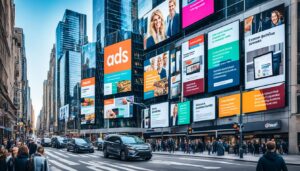Did you know that 21% of online businesses struggle with low site traffic? This challenge can make or break your success. While some rely on direct URL entries, only 22% of visitors come this way. To thrive, you need a mix of strategies that go beyond the basics.
In this guide, I’ll share 17 actionable methods to boost your website’s visibility. These include both organic and paid approaches, ensuring you reach a wider audience. Whether you’re new to this or looking to refine your tactics, there’s something here for everyone.
Continuous learning is key. Resources like e-books and webinars can help you stay ahead. By the end, you’ll have practical, data-backed solutions to elevate your site’s performance.
Key Takeaways
- Low site traffic affects 21% of online businesses.
- Only 22% of visitors come from direct URL entries.
- Combine organic and paid strategies for better results.
- Use e-books and webinars to build your skills.
- Implement 17 proven methods to increase visibility.
Why Driving Traffic to Your Online Shop is Crucial
Traffic is the lifeblood of any ecommerce venture, shaping its growth and success. Without a steady flow of visitors, even the most well-designed shop can struggle to achieve its goals. Understanding the importance of traffic is the first step toward building a thriving business.
The Importance of Consistent Traffic for Ecommerce Success
Consistent traffic ensures that your shop remains visible to potential customers. Did you know that 33% of website traffic comes from organic search? This means that optimizing for search engines is essential. Additionally, 54.4% of Google clicks go to the top three results, emphasizing the need for strong SEO strategies.
Increased traffic directly boosts sales potential. For example, offering discounts can lead to a 57% conversion lift. This shows how attracting the right audience can translate into revenue. The more visitors you have, the higher your chances of converting them into loyal customers.
How Traffic Impacts Sales and Brand Exposure
Traffic not only drives sales but also builds brand authority. Consistent visibility helps establish trust and recognition. With 77% of mobile traffic being relevant to ecommerce, optimizing for mobile users is crucial in 2024. Google prioritizes mobile-friendly sites, making this a key factor in your strategy.
Since 2021, platforms like Shopify have intensified ecommerce competition. Standing out requires more than just a great product—it demands a steady stream of engaged visitors. By focusing on traffic, you can create a strong foundation for long-term success.
| Traffic Source | Impact |
|---|---|
| Organic Search | 33% of total traffic |
| Google Top 3 Results | 54.4% of clicks |
| Mobile Traffic | 77% relevance to ecommerce |
Leverage SEO to Drive More Traffic to Your Online Shop
Search engine optimization (SEO) is a game-changer for boosting your site’s visibility. It’s not just about ranking higher—it’s about connecting with the right audience. By optimizing your site for search engines, you can attract visitors who are genuinely interested in what you offer.
Optimize Your Website for Search Engines
Start by ensuring your site is search engine-friendly. Tools like Ahrefs and SEMrush can help you identify keyword gaps and opportunities. For example, Blackbird Baking Co. used localized keywords to dominate bakery-related searches in their area. This strategy helped them attract nearby customers effectively.
Title tags and meta descriptions are also critical. Keep title tags under 55 characters and meta descriptions capped at 145 characters. The Press blog saw a 20% increase in clicks by optimizing their meta descriptions to be concise and compelling.
Focus on Keyword Research and Meta Tags
Keyword research is the backbone of any SEO strategy. Use tools to find high-performing keywords that align with your content. Internal linking is another powerful tactic. For instance, linking a blog post like “Sofa Buying Tips” to your product page can guide users seamlessly through your site.
Don’t overlook structured data. JSON-LD markup, tested with Google’s tool, can enhance your site’s appearance in search results with rich snippets. This small addition can make a big difference in click-through rates.
“SEO isn’t just about ranking—it’s about creating a seamless experience for your audience.”
By focusing on these strategies, you can ensure your site stands out in a crowded digital space. Start small, track your progress, and refine your approach for long-term success.
Create High-Quality Content That Converts
Great content isn’t just about words—it’s about solving problems. When your blog posts or videos address real pain points, they build trust and loyalty. Take BarkBox: their dog-centric blog earned 12K social shares by focusing on pet owners’ needs.
Blog Posts That Solve Customer Problems
Press’s Squeeze blog tied cold-pressed juice recipes to their products, boosting sales by 30%. Here’s how to replicate this:
- Research common questions (e.g., “How to store fresh juice?”).
- Link blog answers to relevant product pages.
- Use visuals like infographics—Sole Bicycles’ storytelling increased engagement by 40%.
Videos and Podcasts to Engage Your Audience
YouTube reaches 2.7B users, with 85% aged 18–49. Albert’s Jewelry hosted a contest via Facebook Live, attracting 1,000 new fans. For podcasts:
“Transcribe episodes into blog posts like Shopify Masters—it triples your content’s lifespan.”
Pair videos with products (e.g., tutorials) to keep your audience hooked.
Utilize Social Media to Boost Your Online Presence
Social media has become an essential tool for connecting with your audience and growing your brand. Platforms like Instagram and Facebook offer unique opportunities to engage directly with potential customers. With 85% of Shopify social orders coming from Facebook, it’s clear that these platforms are vital for success.
Engage with Your Audience on Instagram and Facebook
Building a community on social media starts with consistent interaction. Blackbird Baking Co. created a pre-launch Instagram community by sharing behind-the-scenes content and hosting Q&A sessions. This approach helped them build excitement and loyalty before their official launch.
Instagram Stories, integrated via tools like Storypop, can also enhance engagement. Albert’s Jewelry used this feature for their Valentine’s contest, encouraging photo submissions and voting. This not only increased participation but also boosted their follower count.
Run Targeted Social Media Campaigns
Targeted campaigns can amplify your reach and conversions. Shopify’s customizable email templates allow you to align your messaging across platforms. For example, Facebook retargeting ads with dynamic product displays can re-engage visitors who previously browsed your site.
User-generated content is another powerful strategy. Encourage your audience to share their experiences using branded hashtags. This not only builds trust but also creates a sense of community around your brand.
“Social media isn’t just about posting—it’s about creating meaningful connections with your audience.”
By leveraging these strategies, you can transform your social media presence into a powerful tool for growth. Start small, experiment with different approaches, and track your results to refine your strategy.
Invest in Paid Advertising for Immediate Results
Paid advertising can deliver quick and measurable results for your business. Unlike organic methods, ads allow you to target specific audiences and scale your efforts efficiently. Whether you’re launching a new product or boosting sales during peak seasons, paid campaigns can make a significant difference.
Google Shopping Ads for High-Intent Shoppers
Google Shopping ads are a powerful tool for reaching high-intent shoppers. Since the launch of free listings in 2020, businesses have seen increased visibility for their products. These ads appear directly in search results, showcasing your items with images, prices, and reviews.
To optimize your product feed for Google Merchant Center, ensure your titles, descriptions, and images are accurate and compelling. For example, during holiday sales peaks, using ROAS (Return on Ad Spend) bidding strategies can maximize your revenue. This approach ensures you’re spending wisely while driving conversions.
Retargeting Ads to Re-Engage Visitors
Retargeting ads are perfect for re-engaging visitors who didn’t convert on their first visit. Bath & Body Works uses urgency-driven messages like “2 left in stock” to encourage immediate action. This tactic taps into the fear of missing out, driving higher click-through rates.
Tools like SEMrush can help you analyze competitor ad spend and refine your strategy. By understanding what works for others, you can create campaigns that stand out. Retargeting ensures your products stay top-of-mind, increasing the likelihood of a purchase.
“Paid advertising isn’t just about spending—it’s about investing in the right audience at the right time.”
By combining Google Shopping ads and retargeting campaigns, you can achieve both immediate and long-term results. For more insights, check out this comprehensive guide on effective advertising strategies.
Build a Strong Email Marketing Strategy
Email marketing remains one of the most effective ways to connect with your audience. It’s a direct line to your customers, allowing you to share updates, promotions, and personalized content. With 57% of first purchases driven by discounts, leveraging email campaigns can significantly boost your results.
Send Personalized Newsletters to Your Subscribers
Personalization is key to making your emails stand out. Segment your audience based on their preferences or purchase history. For example, beauty brands often use discount tiers tailored to different customer groups. This approach ensures your messages resonate with each recipient.
Missguided’s top-bar promo code implementation is a great example. By offering exclusive discounts, they encourage immediate action while building loyalty. Tools like Shopify’s built-in email templates make it easy to customize your newsletters for maximum impact.
Use Email Campaigns to Promote Discounts and Offers
Email is perfect for promoting time-sensitive deals. Abandoned cart flows with urgency timers can recover lost sales. For instance, adding a countdown like “2 hours left” creates a sense of urgency, motivating customers to complete their purchase.
Yelp’s review request emails are another excellent model. By asking for feedback after a purchase, they engage customers and build trust. Here’s how to optimize your campaigns:
- Segment your audience for targeted messaging.
- Use urgency and exclusivity to drive action.
- Incorporate clear calls-to-action for better results.
“Email marketing isn’t just about sending messages—it’s about building relationships with your audience.”
By focusing on these strategies, you can create email campaigns that not only attract attention but also drive meaningful engagement. Start small, test different approaches, and refine your strategy for long-term success.
Optimize Your Website for Mobile Users
Smartphones now account for over three-quarters of retail browsing activity. With Google’s mobile-first indexing, your site must deliver seamless experiences. A 2-second delay can make 53% of shoppers leave—but the right optimization keeps them engaged.
Ensure Fast Load Times and Responsive Design
Start by compressing images with tools like TinyPNG. Sole Bicycles reduced their banner sizes by 60% without quality loss, speeding up page loads. Google PageSpeed Insights helps identify bottlenecks—aim for scores above 85/100.
Accelerated Mobile Pages (AMP) work wonders for product listings. Shopify stores using AMP saw 30% faster checkout times. Test your design across devices with BrowserStack to guarantee responsiveness.
Streamline Navigation for Mobile Shoppers
Breadcrumb menus help users navigate deep categories easily. Implement them like Blackbird Baking Co., whose mobile conversions rose 22% after simplifying their menu structure.
Prioritize thumb-friendly tap targets. Buttons should be at least 48px wide with 8px spacing. Remember: 77% of 2024 retail traffic comes from smartphones. A smooth navigation experience directly impacts sales.
“Mobile isn’t the future—it’s the present. Design for fingers first, then refine for other inputs.”
Collaborate with Influencers to Expand Your Reach
Influencer collaborations are reshaping how brands connect with their audience. By partnering with the right voices, you can tap into their credibility and reach to grow your presence. Whether you’re working with micro-influencers or larger creators, these partnerships can bring authenticity to your marketing efforts.

Partner with Influencers in Your Niche
Finding the right influencers starts with understanding your niche. Use tools like Social Blade to vet micro-influencers based on engagement rates and follower authenticity. For example, BarkBox partnered with pet influencers for unboxing videos, which boosted their visibility and engagement.
Affiliate programs are another effective way to collaborate. Offer 10-15% commissions to incentivize influencers to promote your products. This structure ensures mutual benefit and long-term partnerships.
Use Influencer-Generated Content to Build Trust
Influencer-generated content (UGC) is a powerful tool for building trust. Platforms like TikTok have a 54% contest sharing rate, making them ideal for campaigns. For instance, Press aligned with holistic lifestyle influencers to create authentic content that resonated with their audience.
When repurposing UGC, ensure you have clear rights management. This allows you to use the content across your marketing channels, maximizing its impact.
“Influencers bring authenticity and trust to your brand, making them invaluable partners in today’s digital landscape.”
| Platform | Engagement Strategy |
|---|---|
| TikTok | Creator partnerships with contest sharing |
| UGC rights management for repurposing | |
| YouTube | Unboxing videos for product showcases |
Offer Discounts and Promotions to Attract Shoppers
Discounts and promotions are a proven way to attract and retain customers. They create excitement and encourage immediate action. With 57% of first-time buyers converting through discounts, these strategies are essential for boosting sales.
Create Time-Sensitive Offers to Drive Urgency
Time-sensitive deals are highly effective. They tap into the fear of missing out, motivating customers to act quickly. For example, using countdown timer plugins on Shopify can amplify this effect. Black Friday campaigns often leverage urgency to maximize return on ad spend (ROAS).
Flash sales are another great tactic. Sequence your email campaigns to announce, remind, and close the sale. This keeps your products top-of-mind and drives conversions.
Use Discounts Strategically to Increase Sales
Tiered discount structures, like “Spend $100, save $20,” encourage higher spending. They reward customers while increasing your average order value. POS integration ensures seamless alignment between in-store and online promotions.
Here’s a breakdown of effective discount strategies:
| Strategy | Impact |
|---|---|
| Countdown Timers | Creates urgency |
| Tiered Discounts | Boosts order value |
| Flash Sales | Drives immediate action |
“Discounts aren’t just about lowering prices—they’re about creating value for your customers.”
By implementing these tactics, you can attract shoppers, increase sales, and build lasting customer relationships. Start small, test different approaches, and refine your strategy for maximum impact.
Develop a Referral Program to Encourage Word-of-Mouth
Referral programs can turn your loyal customers into your best advocates. When people trust your brand, they’re more likely to share it with friends and family. This organic growth is one of the most effective ways to expand your reach.
Incentivize Customers to Refer Friends
Offering rewards is a great way to motivate your customers to refer others. For example, Dropbox’s “give $10, get $10” model is a classic example. Both the referrer and the new customer benefit, creating a win-win situation.
Ambassador programs with tiered rewards can also work wonders. As customers refer more people, they unlock higher rewards. This encourages ongoing participation and builds a sense of achievement.
Track and Reward Successful Referrals
To ensure your program runs smoothly, use tools like ReferralCandy. These apps help you track referrals, assign unique codes, and automate rewards. This saves time and ensures accuracy.
Displaying social proof, like testimonials or referral counts, can also boost trust. When potential customers see others benefiting, they’re more likely to join in.
- Use “give $10, get $10” mechanics for simplicity.
- Create tiered rewards for long-term engagement.
- Track referrals with Shopify apps like ReferralCandy.
- Showcase social proof to build credibility.
- Consider B2B referral strategies for wholesale accounts.
| Strategy | Benefit |
|---|---|
| Incentives | Motivates customers to refer others |
| Tiered Rewards | Encourages ongoing participation |
| Tracking Tools | Ensures accuracy and efficiency |
“A referral program isn’t just about growth—it’s about building a community of loyal advocates.”
Use Google Shopping Free Listings to Increase Visibility
Google Shopping free listings have transformed how businesses showcase their products. Since their launch in 2020, these listings have provided a cost-effective way to reach more shoppers. By optimizing your product data, you can ensure your items stand out in search results.
Optimize Your Product Data for Google Shopping
Start by implementing GTINs (Global Trade Item Numbers) in your product feeds. This ensures your items are easily identifiable across engines. For example, a title like “Modern Gray Sectional Sofa – Free Shipping” is both descriptive and optimized for search.
Automated feed tools like DataFeedWatch can streamline this process. They help you manage and update your product data efficiently. Additionally, negative keyword filtering ensures your ads don’t appear for irrelevant queries, improving your ROI.
Take Advantage of Free Listings to Reach More Shoppers
Free listings on Google Shopping are a powerful way to increase visibility without additional costs. Google’s 2023 algorithm updates prioritize high-quality product data, so ensure your feeds are accurate and detailed.
Here’s how to make the most of free listings:
- Use clear, concise titles that include key details like size, color, and shipping options.
- Regularly update your product feeds to reflect inventory changes.
- Monitor performance metrics to identify areas for improvement.
“Free listings aren’t just about visibility—they’re about connecting with shoppers who are ready to buy.”
By leveraging these strategies, you can maximize the impact of Google Shopping free listings and attract more customers to your products.
Focus on Local SEO to Attract Nearby Customers
Local SEO is a powerful tool for connecting with your community. By optimizing your site for local searches, you can attract customers who are ready to visit or buy. With 33% of all searches having local intent, this strategy is essential for businesses targeting nearby shoppers.
Create a Google Business Profile
Start by setting up a Google Business Profile. This free tool helps your business appear in local search results and on Google Maps. Ensure your NAP (Name, Address, Phone) information is consistent across all platforms. This builds trust with both customers and search engines.
Manage your Google Q&A section actively. Respond to questions promptly and provide helpful answers. This not only improves your visibility but also enhances your reputation. For example, a bakery in Lincolnville, ME, used targeted keywords like “ballet shoes Lincolnville ME” to dominate local searches.
Use Local Keywords to Rank Higher
Incorporate local keywords into your content and meta tags. Tools like Google Keyword Planner can help you identify high-performing terms. For instance, “near me” searches have grown significantly, so optimizing for these phrases can boost your rankings.
Implement local schema markup to provide search engines with detailed information about your business. This structured data helps your site appear in rich snippets, increasing click-through rates. Here’s a quick breakdown of effective local SEO strategies:
| Strategy | Benefit |
|---|---|
| Google Business Profile | Boosts local visibility |
| Local Keywords | Targets nearby customers |
| Schema Markup | Enhances search results |
Responding to reviews is another critical step. Use templates to craft thoughtful replies that show appreciation and address concerns. This builds trust and encourages more positive feedback.
“Local SEO isn’t just about ranking—it’s about building relationships with your community.”
By focusing on these strategies, you can create a strong local presence and attract more customers to your business.
Write Guest Posts to Build Backlinks and Authority
Building authority in your niche requires strategic content placement. Guest posting is one of the most effective ways to achieve this. By contributing valuable content to other blogs, you can earn backlinks that boost your site’s credibility and ranking. Did you know that 33% of traffic comes from backlinks? This makes guest posting a must-have strategy.
Reach Out to Blogs in Your Niche
Start by identifying blogs that align with your industry. Tools like HARO (Help a Reporter Out) can connect you with journalists and bloggers seeking expert input. For example, Press used HARO to secure backlinks from high-authority sites, increasing their domain authority significantly.
Another effective method is broken link building. Use tools like Ahrefs to find broken links on relevant blogs. Then, offer your content as a replacement. This not only helps the blog owner but also earns you a valuable backlink.
Include Links to Your Online Shop in Guest Posts
When writing guest posts, strategically include links to your site. The Skyscraper technique works wonders here. Create content that’s better than what’s already ranking, then pitch it to bloggers. For instance, Press’s detailed case studies outperformed competitors, earning them multiple backlinks.
Anchor text ratios are also crucial. Use a mix of branded and keyword-rich anchor texts to maintain a natural profile. Moz’s Domain Authority metrics can help you track your progress and refine your strategy.
- Demonstrate HARO outreach tactics to secure expert roundups.
- Show broken link building via Ahrefs for effective replacements.
- Explain the Skyscraper technique with Press’s content as an example.
- Detail anchor text ratio best practices for natural linking.
- Reference Moz’s Domain Authority metrics to measure success.
“Guest posting isn’t just about backlinks—it’s about building relationships and authority in your niche.”
Analyze Your Traffic Data to Refine Your Strategy
Understanding your website’s performance is the foundation of any successful strategy. By diving into your data, you can uncover valuable insights that drive better results. Tools like Google Analytics 4 (GA4) make it easy to track and interpret your traffic, helping you make informed decisions.
Use Google Analytics to Track Performance
Google Analytics 4 offers advanced features like conversion funnel visualization and multi-channel attribution modeling. These tools help you understand how users interact with your site. For example, you can track pages with the highest engagement or identify where users drop off in the conversion process.
Heatmap integration via Hotjar provides additional insights. It shows where users click, scroll, and spend the most time. This data is invaluable for optimizing your site’s layout and improving user experience.
Identify High-Performing Pages and Campaigns
Analyzing your campaigns helps you allocate resources effectively. Shopify’s built-in analytics dashboards make it easy to monitor performance metrics like page views, session duration, and bounce rate. These metrics reveal which strategies are working and which need adjustment.
A/B testing is another powerful tool. By comparing different versions of a page, you can determine which design or content drives better results. This approach ensures your site is always optimized for maximum impact.
| Metric | Impact |
|---|---|
| Page Views | Measures the number of views per page |
| Session Duration | Indicates how long users stay on your site |
| Bounce Rate | Shows the percentage of users who leave after one page |
| Conversion Rate | Evaluates the percentage of users completing a desired action |
For a deeper dive into traffic analysis, check out this comprehensive guide. It covers everything from tracking traffic sources to interpreting audience demographics.
“Data isn’t just numbers—it’s the story of how your audience interacts with your brand.”
Boost Your Skills with Our Digital Library
Continuous learning is essential for staying ahead in the ever-evolving digital landscape. Our digital library offers a wealth of resources designed to help you grow your expertise. From ebooks to courses, we’ve curated tools that cater to your needs.
Explore Ebooks and Courses to Enhance Your Knowledge
Our collection includes the SEO Mastery for Ecommerce ebook, a must-read for anyone looking to optimize their online presence. For those interested in advertising, our video course on Facebook Ads Conversion Optimization provides actionable insights.
Additionally, we offer a downloadable checklist titled 30-Day Traffic Boost Plan. This resource guides you through practical steps to improve your site’s performance in just one month.
Join Our FREE Webinars for Expert Insights
Stay updated with the latest trends by attending our live webinars. Our upcoming session, 2024 Google Algorithm Updates, will help you adapt to changes and maintain your rankings. These events are designed to provide real-time, expert advice you can implement immediately.
For those looking to save, we offer an exclusive discount on bundle purchases. This allows you to access multiple resources at a reduced price, maximizing your learning potential.
| Resource | Benefit |
|---|---|
| SEO Mastery for Ecommerce | Optimize your site for search engines |
| Facebook Ads Conversion Optimization | Improve ad performance and ROI |
| 30-Day Traffic Boost Plan | Step-by-step guide to increase visibility |
| 2024 Google Algorithm Updates Webinar | Stay ahead of search engine changes |
“Investing in knowledge is the best way to ensure long-term success in the digital world.”
Conclusion
Mastering the art of visibility requires a mix of proven methods and continuous refinement. SEO, social proof, and paid ads remain the top drivers for attracting visitors. By leveraging tools like GA4, you can test and optimize these approaches to ensure they deliver the best results.
Start by implementing one or two strategies immediately. Small, consistent steps often lead to significant improvements over time. For ongoing education, explore our digital library, packed with resources like ebooks and courses designed to enhance your skills.
Ready to take the next step? Join our upcoming webinar to gain expert insights and actionable tips. Sign up today and unlock the potential of your online presence!
FAQ
Why is consistent traffic important for my ecommerce success?
Consistent traffic ensures a steady flow of potential customers to your store. It boosts sales, increases brand exposure, and helps build trust with your audience over time.
How can I optimize my website for search engines?
Start by focusing on keyword research and using relevant meta tags. Ensure your site is fast, mobile-friendly, and has high-quality content that answers your audience’s questions.
What type of content works best for engaging my audience?
Blog posts that solve customer problems, engaging videos, and podcasts are great ways to connect with your audience and keep them coming back for more.
How can social media help boost my online presence?
Platforms like Instagram and Facebook allow you to engage directly with your audience. Running targeted campaigns can also help you reach new customers effectively.
Are paid ads worth the investment for my online shop?
Yes! Google Shopping ads target high-intent shoppers, while retargeting ads help re-engage visitors who didn’t make a purchase initially.
How can email marketing benefit my online store?
Personalized newsletters and campaigns promoting discounts or offers can keep your subscribers engaged and encourage repeat purchases.
Why should I optimize my website for mobile users?
Mobile optimization ensures fast load times and easy navigation, which are crucial for keeping mobile shoppers on your site and converting them into customers.
How can influencers help expand my reach?
Partnering with influencers in your niche can build trust and introduce your brand to their loyal followers, increasing your visibility.
What’s the best way to use discounts and promotions?
Create time-sensitive offers to drive urgency and use discounts strategically to boost sales without compromising your profit margins.
How does a referral program benefit my online shop?
Incentivizing customers to refer friends can lead to organic growth and word-of-mouth marketing, which is highly effective for building trust.
What are Google Shopping free listings, and how do they work?
Free listings on Google Shopping increase your product’s visibility. Optimize your product data to ensure your items appear in relevant searches.
How can local SEO attract nearby customers?
Create a Google Business profile and use local keywords to rank higher in search results, making it easier for nearby shoppers to find you.
Why should I write guest posts for other blogs?
Guest posts help build backlinks, establish authority, and drive traffic to your online shop by reaching new audiences in your niche.
How can I analyze my traffic data effectively?
Use tools like Google Analytics to track performance, identify high-performing pages, and refine your strategies for better results.
Where can I find resources to improve my digital marketing skills?
Explore e-books, courses, and free webinars in our digital library to gain expert insights and enhance your knowledge.








